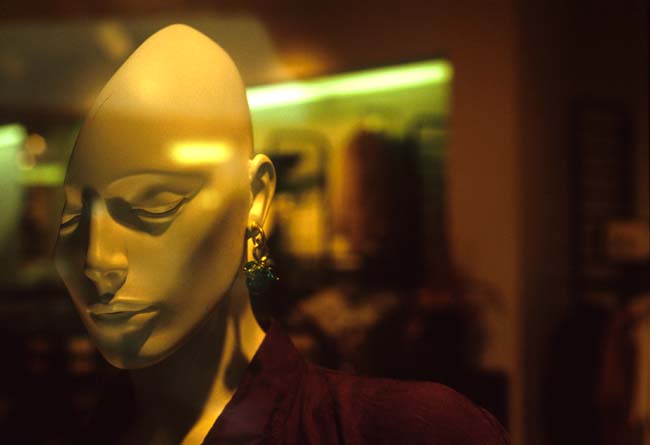
My interest in photographing store windows probably began with this mannequin from a New Orleans mall boutique,
taken on a weekend visit to the city back in 1990. The sadness of her resigned expression, her beauty,
her baldness, and especialy her mutilation, all asked larger and more disturbing questions than whether I
liked the clothes she was displaying. A young women with a shaved head suggests
cancer and concentration camps; the slice through her right eye, parallel with her elegant collar, speaks of
abuse, misogyny and rape in the heart our 'civilized' society.
Why do we sell fashion this way?
Sometimes beautiful, sometimes sensual or erotic,
occasionally sinister and disturbing, always, always surreal: store windows offer a chorus of mixed messages waiting
to be noticed. These windows are frozen one scene plays, unconsciously assembled in small theatres by store managers and window
dressers. They are commentaries on us, on our society and culture. They are mirrors, literally and metaphorically,
for looking at ourselves and who we are.
To skip these
words and get to the thumbnails - click here. 
Still photographs allow us to see the details, the reflections and juxtapositions, that we do not ordinarily
register. Once we are sensitive to the vocabulary however, it becomes impossible to walk down Main Street
or through the shopping mall without an awareness of the peculiar and ironic popping from almost every pane of
glass around us.
Each store, each angle, each reflection conveys a different meaning. Change the angle and the reading changes.
Even international chain stores with their corporate standards and homogenized props tell different stories in their different
local contexts. The story may be the mannequins themselves - blue skinned with spigots, metallic or ivory, heads sliced,
decapitated and limbless, lifelike or blank faced. The story may be in the conversation between the mannequins inside the
window or between the mannequins and the reflected shoppers looking in or passing by. The mannequins might be lovers
or slaves, guardians or conspirators; they may be angered or amused by what they see. Or the story may be almost entirely
outside the window; in what it reflects with the interior providing commentary and accent.

Many famous names in the history of photography have been drawn by the same questions; there is nothing truly new under the sun, only
pendulum swings of fashion and a semiotic drift in our interpretations. In 1912, Eugine Atget set up his tripod in front of the
Hairdresser's Shop Window, boulevard de Strasbourg.
By 1925, two years before his death, he was making conscious use of reflections to build a multi-layered image in
Storefront, avenue des Gobelins.
Atget may not have understood quite why his neighbor, Man Ray, and the wider circle of Paris surrealists found his images so
appealing but the Gobelins storefront drips with the subliminal dream qualities that fascinated them.
Store windows have never been out of the viewfinder since Atget. Berenice Abbot adopted Atget's documentary
method for her studies of New York, including its store fronts. Henri Cartier-Bresson, Edward Weston, Robert
Doisneau, Harry Callahan, Robert Frank, Elliott Erwitt, Lee Friedlander: all have found the occasional
shop window that their camera could not ignore. For less famous and more contemporary examples you need only
spend a few minutes browsing the photography blogs listed at
 .
.
Selected Store Window Images
Below are a few of the store window images on this site. Click on any of the thumbnails see the enlarged
image with some words to explain the things I read in them or why I released the shutter.


